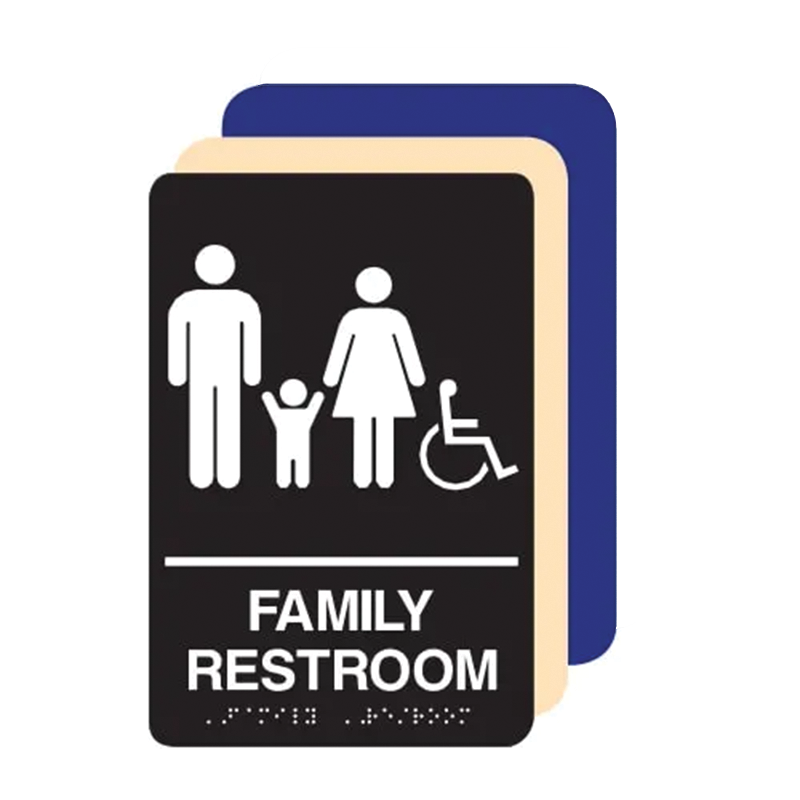The Advantages of Using High-grade ADA Signs in Your Organization
The Advantages of Using High-grade ADA Signs in Your Organization
Blog Article
Discovering the Key Attributes of ADA Indicators for Enhanced Accessibility
In the world of availability, ADA indications serve as quiet yet effective allies, guaranteeing that rooms are navigable and comprehensive for individuals with impairments. By incorporating Braille and responsive elements, these indicators break barriers for the aesthetically damaged, while high-contrast color plans and readable typefaces cater to diverse aesthetic demands.
Significance of ADA Conformity
Making certain compliance with the Americans with Disabilities Act (ADA) is critical for fostering inclusivity and equal accessibility in public rooms and workplaces. The ADA, enacted in 1990, mandates that all public facilities, companies, and transport solutions accommodate individuals with impairments, guaranteeing they appreciate the very same rights and chances as others. Conformity with ADA criteria not just meets legal obligations but likewise improves an organization's track record by showing its dedication to variety and inclusivity.
Among the vital aspects of ADA compliance is the implementation of accessible signage. ADA signs are developed to guarantee that individuals with impairments can quickly navigate through buildings and spaces. These indicators have to follow details standards relating to size, font, color comparison, and positioning to assure presence and readability for all. Effectively applied ADA signs assists get rid of barriers that individuals with disabilities commonly come across, therefore advertising their freedom and self-confidence (ADA Signs).
Furthermore, sticking to ADA guidelines can mitigate the threat of legal effects and prospective fines. Organizations that fall short to follow ADA standards may face fines or suits, which can be both monetarily difficult and damaging to their public picture. Thus, ADA compliance is indispensable to promoting a fair atmosphere for every person.
Braille and Tactile Elements
The incorporation of Braille and tactile aspects into ADA signage symbolizes the concepts of access and inclusivity. It is generally put underneath the equivalent message on signs to make certain that individuals can access the information without visual support.
Responsive components expand past Braille and consist of increased symbols and personalities. These parts are created to be noticeable by touch, allowing individuals to recognize area numbers, bathrooms, departures, and other critical locations. The ADA establishes particular guidelines regarding the dimension, spacing, and placement of these tactile components to enhance readability and guarantee consistency throughout different environments.

High-Contrast Color Design
High-contrast color schemes play an essential function in enhancing the presence and readability of ADA signage for people with visual problems. These plans are important as they take full advantage of the difference in light reflectance between message and background, ensuring that indications are easily noticeable, also from a distance. The Americans with Disabilities Act (ADA) mandates making use of particular shade contrasts to fit those with minimal vision, making it a critical element of conformity.
The efficacy of high-contrast shades depends on their capability to stand out in different lights conditions, consisting of poorly lit atmospheres and locations with glow. Usually, dark message on a light background or light message on a dark background is used to attain optimal comparison. Black message on a white or yellow history gives a stark aesthetic distinction that assists in quick acknowledgment and understanding.

Legible Fonts and Text Dimension
When thinking about the design of ADA signage, the choice of legible fonts and ideal message visit their website size can not be overemphasized. The Americans with Disabilities Act (ADA) mandates that typefaces must be not italic and sans-serif, oblique, script, highly decorative, or of unusual form.
The size of the text additionally plays an essential role in access. According to ADA standards, the minimal message elevation need to be 5/8 inch, and it needs to boost proportionally with watching range. This is particularly crucial in public rooms where signage needs to be checked out swiftly and accurately. Consistency in text size adds to a cohesive visual experience, helping individuals in browsing settings effectively.
Additionally, spacing in between letters and lines is integral to clarity. Adequate spacing protects against characters from appearing crowded, boosting readability. By adhering to these criteria, designers can dramatically improve access, guaranteeing that signs serves its designated objective for all individuals, despite their aesthetic abilities.
Reliable Placement Techniques
Strategic positioning of ADA signage is necessary for making best use of ease of access and making sure compliance with lawful standards. Effectively positioned indications lead individuals with impairments properly, facilitating navigation in public areas. Secret factors to consider consist of distance, elevation, and exposure. ADA standards specify that signs should be mounted at a height between 48 to 60 inches from the ground to ensure they are within the line of sight for both standing and seated people. This typical height variety is essential for inclusivity, allowing mobility device customers and people of differing elevations to accessibility details effortlessly.
Furthermore, indicators need to be placed surrounding to the latch side of doors to allow simple identification prior to entry. Uniformity in indication positioning throughout a facility boosts predictability, minimizing confusion and boosting general user experience.
Final Thought
ADA indicators play an important function in promoting access by incorporating attributes that deal with the requirements of people with impairments. Integrating Braille and responsive elements guarantees essential information comes to the aesthetically damaged, while high-contrast color pattern and readable sans-serif typefaces boost visibility across different illumination problems. Reliable positioning strategies, such as appropriate installing heights and calculated areas, better help with navigation. These aspects collectively promote a comprehensive setting, emphasizing the relevance of ADA conformity in making certain equivalent accessibility for all.
In the world of access, ADA indications serve as silent yet powerful allies, making certain that rooms are accessible and inclusive for people with impairments. The ADA, enacted in 1990, mandates that check it out all public facilities, companies, and transportation services accommodate people with handicaps, guaranteeing they take pleasure in the exact same rights and opportunities as others. ADA Signs. ADA indicators are created to guarantee that individuals with disabilities can easily browse discover this with buildings and areas. ADA standards stipulate that indicators must be mounted at an elevation between 48 to 60 inches from the ground to guarantee they are within the line of view for both standing and seated people.ADA indications play an important duty in promoting accessibility by incorporating features that resolve the needs of people with impairments
Report this page